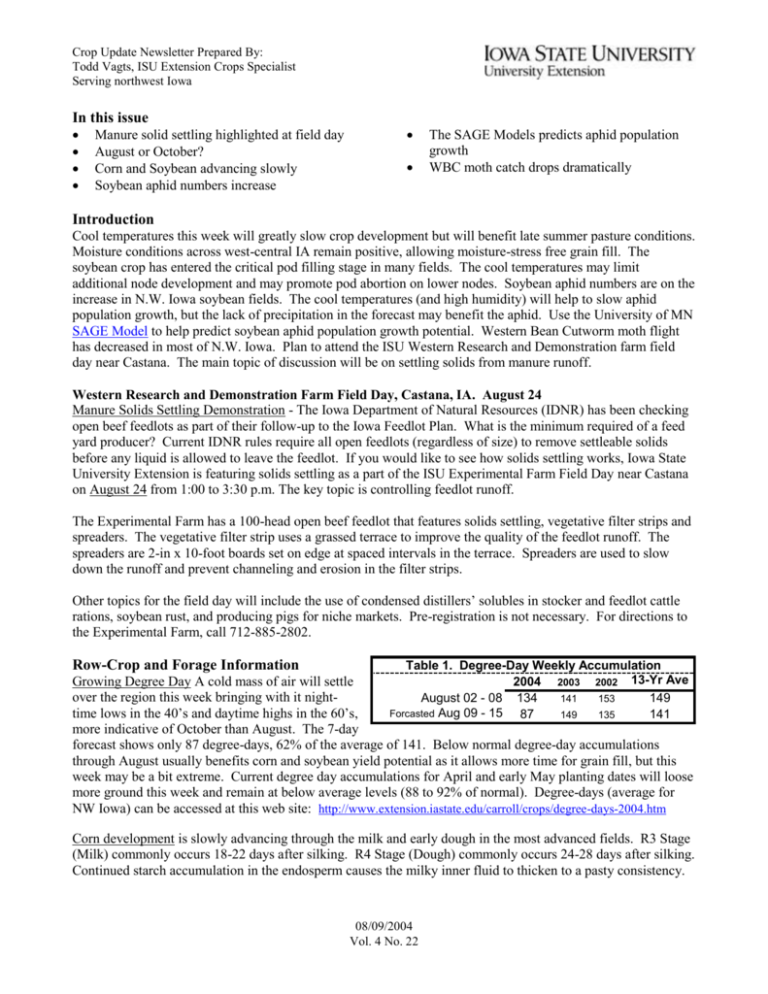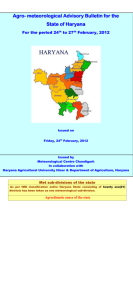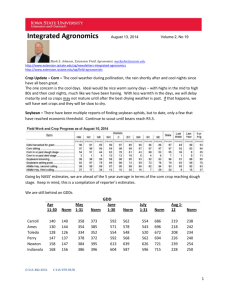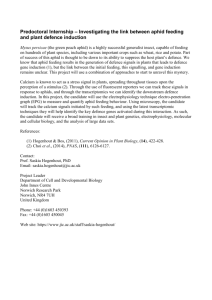Microsoft Word - Iowa State University Extension and Outreach
advertisement

Crop Update Newsletter Prepared By: Todd Vagts, ISU Extension Crops Specialist Serving northwest Iowa In this issue Manure solid settling highlighted at field day August or October? Corn and Soybean advancing slowly Soybean aphid numbers increase The SAGE Models predicts aphid population growth WBC moth catch drops dramatically Introduction Cool temperatures this week will greatly slow crop development but will benefit late summer pasture conditions. Moisture conditions across west-central IA remain positive, allowing moisture-stress free grain fill. The soybean crop has entered the critical pod filling stage in many fields. The cool temperatures may limit additional node development and may promote pod abortion on lower nodes. Soybean aphid numbers are on the increase in N.W. Iowa soybean fields. The cool temperatures (and high humidity) will help to slow aphid population growth, but the lack of precipitation in the forecast may benefit the aphid. Use the University of MN SAGE Model to help predict soybean aphid population growth potential. Western Bean Cutworm moth flight has decreased in most of N.W. Iowa. Plan to attend the ISU Western Research and Demonstration farm field day near Castana. The main topic of discussion will be on settling solids from manure runoff. Western Research and Demonstration Farm Field Day, Castana, IA. August 24 Manure Solids Settling Demonstration - The Iowa Department of Natural Resources (IDNR) has been checking open beef feedlots as part of their follow-up to the Iowa Feedlot Plan. What is the minimum required of a feed yard producer? Current IDNR rules require all open feedlots (regardless of size) to remove settleable solids before any liquid is allowed to leave the feedlot. If you would like to see how solids settling works, Iowa State University Extension is featuring solids settling as a part of the ISU Experimental Farm Field Day near Castana on August 24 from 1:00 to 3:30 p.m. The key topic is controlling feedlot runoff. The Experimental Farm has a 100-head open beef feedlot that features solids settling, vegetative filter strips and spreaders. The vegetative filter strip uses a grassed terrace to improve the quality of the feedlot runoff. The spreaders are 2-in x 10-foot boards set on edge at spaced intervals in the terrace. Spreaders are used to slow down the runoff and prevent channeling and erosion in the filter strips. Other topics for the field day will include the use of condensed distillers’ solubles in stocker and feedlot cattle rations, soybean rust, and producing pigs for niche markets. Pre-registration is not necessary. For directions to the Experimental Farm, call 712-885-2802. Row-Crop and Forage Information Table 1. Degree-Day Weekly Accumulation 2004 2003 2002 13-Yr Ave Growing Degree Day A cold mass of air will settle over the region this week bringing with it nightAugust 02 - 08 134 141 153 149 Forcasted Aug 09 15 time lows in the 40’s and daytime highs in the 60’s, 87 149 135 141 more indicative of October than August. The 7-day forecast shows only 87 degree-days, 62% of the average of 141. Below normal degree-day accumulations through August usually benefits corn and soybean yield potential as it allows more time for grain fill, but this week may be a bit extreme. Current degree day accumulations for April and early May planting dates will loose more ground this week and remain at below average levels (88 to 92% of normal). Degree-days (average for NW Iowa) can be accessed at this web site: http://www.extension.iastate.edu/carroll/crops/degree-days-2004.htm Corn development is slowly advancing through the milk and early dough in the most advanced fields. R3 Stage (Milk) commonly occurs 18-22 days after silking. R4 Stage (Dough) commonly occurs 24-28 days after silking. Continued starch accumulation in the endosperm causes the milky inner fluid to thicken to a pasty consistency. 08/09/2004 Vol. 4 No. 22 Crop Update Newsletter Prepared By: Todd Vagts, ISU Extension Crops Specialist Serving northwest Iowa The reduced fluid and increased solids within the kernel at this time produce a doughy consistency. Just prior to R5, kernels along the length of the ear begin to dent or dry on top. 2000 Figure 1. Degree-day accum ulation and Corn Developm ent by Planting Date (N.W. IA) 13-Yr Averages Degree-Days (base 50) and Growth Stage 1900 20-April 30-April 1800 10-May Dough---------------------------------------- 1700 1600 1500 ---------------------------------------------------------------------1400 Current Forecasted 13 -A ug 8Au g 3Au g 1300 29 -J ul Soybean Development has moved into the seed fill stage in many fields. This stage is characterized by rapid seed filling and redistribution of dry weight and nutrients within the plant. At initial R5 (the R5 stage is reached when one pod in the uppermost four nodes contains a seed 1/8 inch wide) reproductive development can range from flowers just open to pods containing seeds 8 mm long. Root growth and expansion slows; therefore it's important that water be available where the developed roots are. At R5.5 the plant attains its maximum height, node number and leaf area. The nitrogen fixation rate peaks and begins to drop. The seeds at this point will begin a rapid period of dry weight and nutrient accumulation. As development approaches R6, nutrients accumulated in the leaves and petioles begin to be redistributed to the seed. Current Forecasted April 10 Date What affect will this week’s cool temperature have on soybean development and yield? Dr. Palle Pedersen (ISU Extension Soybean Specialist) thinks we may observe plants with fewer nodes and the loss of pods from the bottom five nodes; ultimately reducing the potential for outstanding soybean yields. Crop Growth Model Statistics: The most recent model runs (August 01) suggest yield potential for corn and soybean is still strong, indicating greater than 100% of the previous 4-year (model) average for all locations. Observe the daily development and yield potential “trend” for corn and soybean plants from estimates given by growth simulation models using local weather data at this web address: http://www.extension.iastate.edu/carroll/crops/crop-modeling.htm Pest Management Soybean Aphid Aphid populations are becoming much easier to find in area soybean fields, yet they still remain below the 250 aphid/plant threshold. Minnesota’s pest survey (August 6) has now found 42 fields (out of 165 sampled) in the state with (low) aphid numbers, still much below last year. Crop scouts in N.E. Nebraska are finding increasing aphid numbers as well. Joel DeJong (ISU Extension Crop Specialist) in far N.W. Iowa stated this morning that aphid numbers are approaching treatable levels in several fields in his area. This is definitely the time to be vigilant. Current and forecasted weather conditions (cool and dry) could still allow SA reproductive potential to be high. Interestingly though, temperatures for this week are below optimum and projected aphid population growth (SAGE Model) is less than if temperatures were warmer. Estimating aphid population growth. The University of MN recently released their aphid population growth calculator called the SAGE model which can be used to help predict the growth potential of an existing aphid populations based on current aphid numbers and the 7-day weather forecast. The SAGE model can be accessed at this URL: http://www.soybeans.umn.edu/crop/insects/aphid/aphid_sagemodel.htm Click on "Soybean aphid growth estimator v1-2.xls" following the second paragraph. This is a Microsoft Excel program. 08/09/2004 Vol. 4 No. 22 Crop Update Newsletter Prepared By: Todd Vagts, ISU Extension Crops Specialist Serving northwest Iowa The developers of the SAGE model state that the model will predict an average rate of population build up (expressed as the time required for populations to double). The model will also predict when the population is expected to reach a threshold of 250 aphids per plant. The model is likely to over-estimate aphid populations in the field. Use this model as a guide to determine when to resample a field (preferably at least 2-3 days before threshold is reached). Weather data can be obtained from www.weather.com (input your location into the local forecast box). Soybeans are currently at R4 (3/4 inch pod on one of upper 4 nodes) to R5 (beginning pod fill) across much of the region. The University of MN researchers (developers of the 250/plant threshold) still recommend using the 250 aphids/plant threshold through R5. See my SBA page for more information on identification, scouting and temperature and humidity trends compared to last year. http://www.extension.iastate.edu/carroll/crops/soybean-aphid.htm Use pictures at this web address (http://www.extension.iastate.edu/carroll/crops/soybean_aphid_leaf_counts.htm) to help estimate aphids per leaf. Print the pictures and take them to the field. The SAGE Models predicts (for Carroll, IA) aphid populations to double every 2.8 days with the extended 7-day forecast (August 9 – 15). Results from the SAGE Model with varying aphid numbers are given in the following table. Soybean Aphid Estimated Population Growth Location: Carroll, IA Current Date: 08/09/2004 Today's Population Population in 7 days 5 28 10 56 Aphids/Plant 20 111 40 376 80 446 Days to Threshold 16 13 Days 10 7 5 Western Bean Cutworm WBC moth flight appears to have peaked in most counties in N.W. Iowa. The Ida County light trap is now picking up only a few moths per night. Scouting for eggs and hatched larva is still recommended in corn that is pre or early post tassel (replant or specialty corn). Moth catch data for the state of IA can be seen at this web address: http://latrodectus.ent.iastate.edu/westernbeancutworm/. Graphed data for N.W. Iowa can be seen at this URL: http://www.extension.iastate.edu/carroll/crops/wbc-2004.htm 08/09/2004 Vol. 4 No. 22 Crop Update Newsletter Prepared By: Todd Vagts, ISU Extension Crops Specialist Serving northwest Iowa For further information pertaining to this newsletter; please contact me or any of the county extension offices. This newsletter can also be accessed on-line at http://extension.iastate.edu/carroll/crops/newsletter_2004.htm. If you would like this letter to be emailed directly to you, please send an email with the desired email address to vagts@iastate.edu. ****************************************************************************** Todd Vagts Iowa State University Extension Field Specialist, Crops 1240 D. Heires Avenue Office: 712-792-2364 Carroll, IA 51401 Cell: 712-249-6025 Email: vagts@iastate.edu Fax: 712-792-2366 Web Page: http://extension.iastate.edu/carroll/crops/homepage.html Provided to you by: IOWA STATE UNIVERSITY OF SCIENCE AND TECHNOLOGY COOPERATIVE EXTENSION The information given in this publication is for educational purposes only. Reference to commercial products is made with the understanding that no discrimination is intended and no endorsement by Iowa State University with any specific product(s) used in this is implied Iowa State University and U.S. Department of Agriculture cooperating Extension programs are available to all without regard to race, color, national origin, religion, sex, age or disability. 08/09/2004 Vol. 4 No. 22






